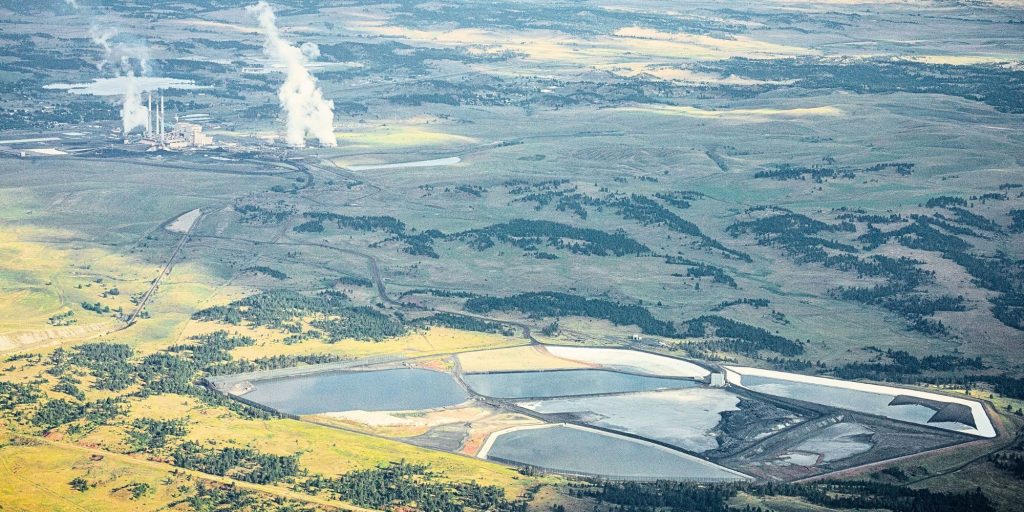Above: Coal ash at the generating plant in Colstrip, Montana, is kept in water-filled ponds. 91% of coal ash ponds around the U.S. leak into local aquifers contaminating groundwater.
After pressure from WORC members and allies, the Environmental Protection Agency finalizes their Legacy Coal Combustion Residuals (CCR) Surface Impoundments Rule, protecting drinking water and air from toxic coal ash contamination.
The Biden administration, through the Environmental Protection Agency (EPA), took a huge step this month to ensure that frontline communities out West are protected from the impacts of coal ash. The finalized Legacy Coal Combustion Residuals (CCR) Surface Impoundments Rule (“Legacy CCR Rule”) rule requires the safe management of coal ash impoundments that were up until now, unregulated at the federal level. “This is an important step in holding polluters accountable and ensuring our groundwater resources are cleaned of pollutants and restored, “ said Beth Kaeding, a former chair of Northern Plains Resource Council. “Energy corporations have made enormous profits for decades, and communities should not bear the burden of contaminated water that risks their health and local livelihoods.”
What is coal ash?
Coal ash is the byproduct of burning coal in a coal plant and is known to cause severe health problems from hazardous contaminants like arsenic, radium, and lead. Coal ash left in dry impoundments often blows into nearby communities causing contamination of surfaces and health problems for people breathing it in. The ash can also leak down into groundwater creating blooms of pollution that can threaten drinking water that communities rely on. 91% of coal plants – 265 out of 292 – are contaminating groundwater with coal ash pollutants above federal safety standards.
“Energy corporations have made enormous profits for decades, and communities should not bear the burden of contaminated water that risks their health and local livelihoods.”
Beth Kaeding, a former chair of Northern Plains Resource Council
In 2015, EPA released the Coal Combustion and Residual (CCR) Rule, also known as the “Coal Ash Rule”, which sought to address the growing crisis of coal ash in this country. Unfortunately, due to pressure from the coal industry, that initial rule was severely weakened, leading to loopholes that excluded legacy ponds (coal ash suspended in water) and inactive landfills that had retired prior to the rule release in 2015.
Due to the exclusion of legacy ponds and landfills in the 2015 rule, an Earthjustice investigation discovered that at least half a billion tons of coal ash had been exempt from the rule. They made it clear that even if a coal plant retired decades ago, the impacts of coal ash on soil, groundwater, and frontline communities would still remain toxic and dire.
Keep up to date with grassroots organizing in the West with WORC’s newsletter.
The new rule tackles legacy coal ash
After litigation pressure from Earthjustice and other organizations, plus thousands of comments from affected residents and members of WORC, the most egregious loopholes that had been left open from the initial rule, have finally been closed. Legacy ponds and landfills are now required to be regulated, thanks to EPA’s finalized rule that addresses impoundments and units that were left out of the 2015 rulemaking. Under the final rule, EPA also established groundwater monitoring, corrective action, closure, and post closure care requirements for these legacy areas. In the 2015 version, 36 ponds or landfills at 15 plants throughout the WORC region would have been exempted. Now, with EPA’s final legacy coal ash rule, at least 14 plants and over 35 ponds and landfills within our western region will finally be regulated to ensure that communities are protected from health and environmental impacts caused by coal ash. It’s important to note that this does not cover the full universe of legacy ponds and landfills within our region and EPA will continue to build their exhaustive list of locations that this rule will impact. EPA already significantly updated their list of locations impacted between the proposed and final rule, thanks to input from public comments like WORC’s–expanding from 127 legacy surface impoundments at 59 locations to 194 surface impoundments located at 85 facilities. It will take diligent follow up and pressure from groups like WORC to ensure that their list is expansive and inclusive of the many legacy ponds and landfills that exist throughout the West.
“These coal-fired power plants must clean up their messes as a part of doing business,” said Kaeding. “Proper clean up of coal ash ponds will also create long-term, good-paying industrial jobs using the skills of existing coal community work forces.”
Below are coal plants in the WORC region that are required by the new rules to clean up their coal ash.
Montana
- Colstrip: At least 2 landfills
- J. E. Corette: At least 2 ponds and 1 unregulated landfill
- Lewis & Clark: At least 2 landfills
North Dakota
- Antelope Valley: At least 1 landfill
- Coal Creek: At least 5 landfills
- Coyote: At least 3 landfills
- Leland Olds: At least 1 landfill
- Milton Young: At least 7 landfills
- RM Heskett: At least 1 landfill
- Stanton: At least 2 landfills
- WJ Neal: At least 1 pond
Wyoming
- Naughton: At least 1 landfill
- Osage: At least 2 ponds and 2 landfills
- Wyodak: At least 1 pond and 1 landfill
The Jim Bridger power plant in Wyoming has one landfill currently left unregulated. WORC and Powder River will continue working to get it added to the list in coming months
Learn more:
Toxic Coal Ash Threatens Groundwater Around the US
Coal Ash Rule Rollbacks Keep Rolling In
Addressing The Collapse of the Coal Industry

Yes, I want to help WORC elevate Western voices and hold decision-makers accountable!





